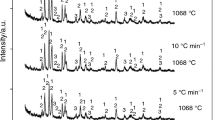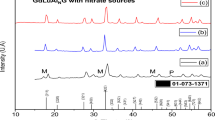Abstract
119Sn Mössbauer spectroscopy and X-ray diffraction were used to study the state of tin in opaque lead rich glazes, where small cassiterite (SnO2) particles serve as opacifiers.
Similar content being viewed by others
References
Vendrell, M., Molera, J. and Tite,M. S., Optical Properties of Tin-Opacified Glazes, Archaeometry 42(2000), 325.
Mason, R. B. and Tite, M. S., The Beginnings of Tin-Opacification of Pottery Glazes, Archaeometry 39(1) (1997), 41.
Tite, M. S., Freestone, I., Mason, R., Molera, J., Vendrell-Saz, M. and Wood, N., Lead Glazes in Antiquity-Methods of Production and Reasons for Use, Archaeometry 40(1998), 241.
Piccolpasso, C., I tre libri dell'arte del vasaio, Atesa Editrice, 1974.
Molera, J., Pradell, T., Salvado, N. and Vendrell-Saz, M., Evidence of Tin Oxide Recrystallization in Opacified Lead Glazes,J. Am. Ceram. Soc. 82(10) (1999), 2871.
Ali, N. J., Gillespie, P. A. and McWhinnie, W. R., The Chemistry of Simple Ceramic Glazes, I. 57Fe Mössbauer Studies of Iron-Containing Glazes and Glasses, Polyhedron 9(7) (1990), 999–1007.
Endo, K., Haruta, H., Honda, C., Katada, M., Nakahara, H., Nakada, M., Saeki, M. and Aratono, Y., Mössbauer Spectroscopic Study on Glaze of Pottery, Hyp. Interact. 91(1–4) (1994), 645–649.
Grosse, G., Mos-90, version 2.2, Technical University of Munich, 1992.
Stievano, L., Calogero, S., Wagner, F. E., Galvagno, S. and Milone, C., Mössbauer Characterisation of Carbon Supported Ruthenium-Tin Catalysts, J. Phys. Chem. 103(B) (1999), 9545–9556.
Clark, A. M., Fejer, E. E., Donaldson, J. D. and Silver, J., The 119Sn Mössbauer Spectra, Cell Dimensions, and Minor Element Contents for some Cassiterites, Mineral. Mag. 40(1976), 895.
Johnson, J. A., Johnson, C. E., Williams, K. F. E., Holland, D. and Karim, M. M., Mössbauer Spectra of Tin in Float Glass, Hyp. Interact. 95(1995), 41–51.
Dannheim, H., Oel, J. and Tomandl, G., Mössbauer-Effekt an Zinn in Silikatgläsern, Glastechn. Berichte 49(1975), 170–175.
Work in collaboration with Dr. Fabbri and Dr. Gualtieri of the IRTEC-CNR of Faenza (Italy) and with Prof. M. Tite of the University of Oxford.
Author information
Authors and Affiliations
Rights and permissions
About this article
Cite this article
Stievano, L., Bertelle, M., Calogero, S. et al. The Application of 119Sn Mössbauer Spectroscopy to the Investigation of Glass Coatings: Evolution of the Tin Species in Lead-Rich White Glazes. Hyperfine Interactions 154, 83–94 (2004). https://doi.org/10.1023/B:HYPE.0000032027.34996.d6
Issue Date:
DOI: https://doi.org/10.1023/B:HYPE.0000032027.34996.d6




